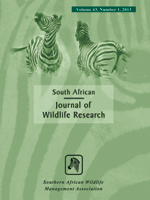African wild dog (Lycaon pictus) populations and their geographic distributions have been greatly reduced due to direct human persecution and habitat reduction; however, remnant groups still manage to persist on private reserves and farmland. Farmland, especially game farming areas, can potentially be suitable for wild dog conservation. However, little is known about them in these areas. To increase our understanding regarding the presence and general ecology of wild dogs on private land we used a camera trapping picture database initially used to census leopards (Panthera pardus) to report on wild dog presence on private farmland and reserves within the Waterberg Biosphere, South Africa. We identified nine different wild dogs from the camera trap images and all wild dog signs were restricted to Lapalala. We further supplemented the data set with opportunistically collected scats to report on wild dog prey use. Only three species could be identified in the scats, namely bushbuck (Tragelaphus scriptus), impala (Aepyceros melampus) and greater kudu (Tragelaphus strepsiceros), with bushbuck the most important prey species. Our results show that some wild dogs still persist on private land in the Waterberg, confirming that private land can play an important role in wold dog conservation. We suggest that conservation efforts focussing on mitigation actions to improve local tolerance towards wild dogs would be the most efficient action to secure a viable wild dog population.
How to translate text using browser tools
1 April 2013
The Diet and Presence of African Wild Dogs (Lycaon pictus) on Private Land in the Waterberg Region, South Africa
Rivona Ramnanan,
Lourens H. Swanepoel,
Michael J. Somers
ACCESS THE FULL ARTICLE
camera trapping
large carnivores
non-invasive survey
scat analysis
wildlife monitoring





